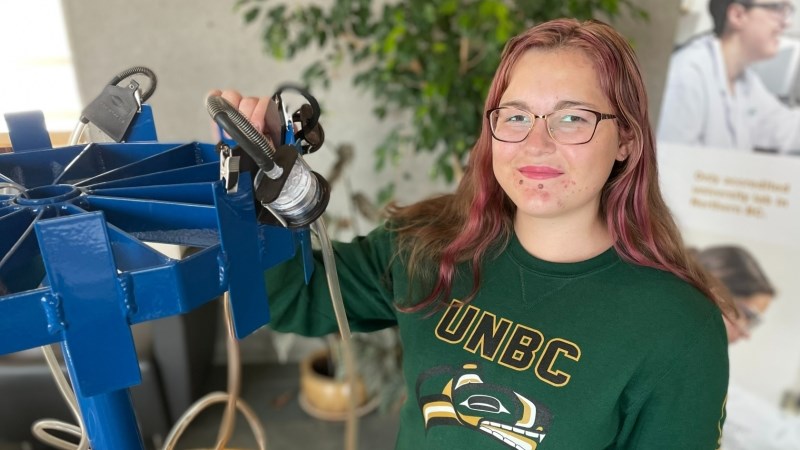Environmental Engineering student Madeline Clarke has built a unique machine to assess indoor air in industrial settings which is believed to be the first-of-its-kind in Canada and one of only a handful in the world.
Clarke, who will be entering her second year at the University of Northern British Columbia (UNBC) this fall, designed and built a rotating indoor Workplace Atmosphere Sampler (WAM) in less than four months while working at the Northern Analytical Laboratory Service (NALS) at UNBC.
She constructed the industrial hygiene air sampling machine at a fraction of the cost of the comparable professionally built WAMS.
Her custom design features a battery-operated, turntable WAM that can be set to sample 12 different parameters at a time.
NALS Quality Assurance Officer Ann Duong says the current industry standard for workplace atmospheric sampling is to use individual pumps on employees or a stationary stand with one sampler.
“That’s basically the standard that is sold commercially, even for outdoor settings, so to have something like this where you can fit 12 samplers has never been done before,” says Duong.
“There are different concentration gradients that may be missed by a static sampler that will be captured by the rotating samplers on this WAM.”
In addition to providing better analysis of indoor industrial hygiene, Duong says the implications could be even larger if the WAM can be used for outdoor sampling, as well.
While the task was a mechanical engineering challenge rather than an environmental one, Clarke says engineering, in general, is about solving problems.
“It had to spin at three rotations-per-minute, it had to be battery-powered and it had to sample at a specific height, so it was more about figuring out ways to solve those problems.”
In addition to researching how motors work, the industrious student from Trail, B.C. learned how to solder and use a 3D printer as she developed her tabletop WAM built from a display turntable for information pamphlets.
Clarke says the WAM will be used for a project with WorkSafe BC.
“The plan right now is to use it to evaluate workers’ exposure to welding fumes because those are really harmful, so it would help ensure ventilation systems in the workplace are working and could help determine if special protective equipment needs to be used.”
While it’s too early to say if this project has sparked any future career paths, Clarke is thrilled with her summer job experience, “It almost doesn’t feel real that I’m doing this kind of work, especially when I’ve only completed one year of university. It’s incredible.”
Clarke is enrolled in the joint UNBC/UBC Bachelor of Applied Science in Environmental Engineering Degree, which sees students attend UNBC for the first two years, UBC for years three and four and then a final semester at UNBC that includes a capstone design project.
“I thought it would be really great to get the small university experience and the larger school experience and, so far, it’s been even better than I imagined.”



